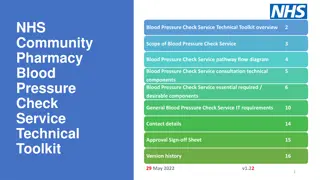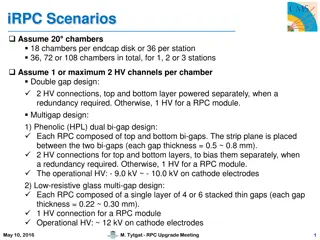EPAC Front End Technical Meeting 2022 Overview
The EPAC Front End system features picosecond-pumped and nanosecond-pumped OPCPAs to deliver a 1.5 J seed to the Ti:Sapphire amplifier. The system provides a full spectrum of 1.5 J and shaped spectra of over 0.5 J with 4 ns FWHM and more than 100 nm FWHM. The setup includes multiple amplifiers, optical components for spectral shaping, energy mode selection, and stability features, ensuring precise and efficient operation. Explore details on the system's layout, components, and future plans in this comprehensive overview.
Uploaded on Oct 06, 2024 | 0 Views
Download Presentation

Please find below an Image/Link to download the presentation.
The content on the website is provided AS IS for your information and personal use only. It may not be sold, licensed, or shared on other websites without obtaining consent from the author.If you encounter any issues during the download, it is possible that the publisher has removed the file from their server.
You are allowed to download the files provided on this website for personal or commercial use, subject to the condition that they are used lawfully. All files are the property of their respective owners.
The content on the website is provided AS IS for your information and personal use only. It may not be sold, licensed, or shared on other websites without obtaining consent from the author.
E N D
Presentation Transcript
EPAC Front End ISTAC Technical Meeting 2022 Nicholas Stuart
Introduction The EPAC front end has 108 net amplification, split between ps-pumped and ns-pumped OPCPAs to deliver a 1.5 J seed to the Ti:Sapphire amplifier. EPAC Front End 1.5 J full spectrum; > 0.5 J shaped spectrum 4 ns FWHM > 100 nm FWHM 800 +/- 10 nm 10 Hz, 1 Hz, Shot on Demand Output pulse energy Output pulse duration Output Bandwidth Central wavelength Repetition rate Shot to shot pulse energy stability < 2 % RMS
EPAC Front End Schematic 1. Picosecond-pumped OPCPAs. Optically locked to Ti:Sa master oscillator. 30 ps pump, 1.5 mJ signal. 2. Stretcher. Tuneable 70-120 ps stretcher before injection into Offner stretcher. 4 ns pulses out. 3. Nanosecond-pumped OPCPAs. 7 J total pump energy from synchronised pump laser. 1.5 J signal. 4. Front End Output. Spectral shaping (static), energy mode selection, rep-rate control, optical isolation, fast beam stabilisation injection + correction. Image-relayed all FE amplifiers to Ti:Sa, with < /20 total chromatic aberration across 110 nm bandwidth.
Picosecond-Pumped OPCPAs Completed optical design. Three amplifiers operate at LiDT. Spec Required Designed Pump Energy 25 mJ 20 mJ Pump stability 1% 1% Signal energy 1.5 mJ 5.4 mJ Signal bandwidth 110 nm 160 nm Signal stability 2% 1% 109 6 x 109 ASE Contrast Facility Operations Features: - Near-field, far-field (seed + pump) & spec. per amp. 1D Model - Auto-align ps-OPCPA injection + output to stretcher. - Pump + crystal motorised alignment tuning for gain. - Pump timing auto-align (spectrometer feedback). - Remote laser turn-on/off. - Eye-safe warm-up/standby considerations.
PS-OPCPA Lasers The Ti:Sa oscillator (Laser Quantum) and ps-pump (Ekspla) have arrived and successfully tested. Pump FAT: Max pump energy 34mJ Stability (covers off) = 0.44% PS OPCPA PUMP SEED A pre-build of the ps-OPCPA system components is scheduled in Jan-23.
Stretcher Section The ps-OPCPA output will be stretched to 4ns duration to inject into the ns-OPCPA amplifiers. Compressed pulse length tuning in experimental areas will be performed with a 50 ps scanning range tuneable stretcher before the primary Offner stretcher. Stretcher spherical imaging optics in manufacture (Aperture Optical Sciences). /40 p-v, /250 RMS target specification. Scatter & wavefront aberrations in the stretcher significantly contribute to pulse pedestal noise. Tender out for 1500 l/mm transmission gratings. Starting manufacture of large optic mounts. 4 ns Output Diagnostics Offner Stretcher 2ns Probe Tuneable Stretcher 15 ps Input
Tuneable Stretcher Change of design from two-grating (Treacy) to a grism (grating +prism) pair in a folded geometry. Better management of high-order spectral phase. Compensation upto FiOD included. Higher tolerance to material dispersion in the beamline. From 30cm to 3m of fused silica. 1350l/mm to 1500l/mm gratings. Total diffraction efficiency increased from 20% to 60%. Prototype testing on the Vulcan OPPEL beamline to verify alignment procedure and measurement of the tuneable stretcher spectral phase contribution (SPIDER, spectral interferometry).
Nanosecond-pumped OPCPA Design of ns-OPCPAs now final and in manufacture. Current 1D amplification model predicts 2.8 J signal with 5 J pump. (1.5 J requirement) OPA4 Input OPA1 OPA3 OPA2 Output OPA4 output ~17mm diameter and expanded to 20mm. Facility Operations Features: - NF + FF every amplifier, spec. every two amplifiers. - Auto-align ns-OPCPA injection + output. - Auto-align pump output + crystal motorised tuning.
Ns-OPCPA Pump Custom diode-pumped Nd:YLF Gigashot pump laser in manufacture (Northrop Grumman Core Edge Optronics). Delivery scheduled Jul-23. 7 J, 527 nm, 10 Hz top-hat spatial profile. Top-hat 4ns FWHM, 100ps rise/fall pulse, 25ps jitter with shaping. <0.5% RMS energy will ensure we meet our 2% stability spec. Customised design improves their existing design to create a stable and reliable long-life pump laser. Remote laser turn-on/off and monitoring (EPICS). Eye-safe warm-up/standby considerations to maintain laser readiness when not in use for long periods. Example Uses NG-CEO Nd:YLF amplifier modules up to 22mm rod diameter.
Front End Output Spectral shaping of ns-OPCPA output Spectral/temporal shaping. The top-hat temporal profile of the ns-OPCPA will need to be shaped to compensate pulse-front gain saturation shaping in the Ti:Sa. Shaping attenuates energy from 1.5 J to 0.5 J. Energy attenuation (modes 3 & 4), to reduce intensity in experimental areas for set-up. 99% reflector & 95% reflector + variable waveplate polariser for continuous coverage. AR compensator window of same thickness is inserted when energy attenuation is not used. Fast beam pointing stabilisation mirror and CW injection. Repetition-rate control. 10Hz, 1Hz, single-shot. Optical isolation of the front-end (Pockels Cell).
Front End Output Layout Current status: Final detailing and manufacture. Provision has been made for an interchangeable pinhole array in 1:1 VSF. We are currently assessing expected ns-OPCPA output profile to inform this requirement.
EPAC Probe Laser A portion of the stretcher output (double-pass, 2ns) provides an optically locked seed for to a Ti:Sa amplifier system. Amplification from 3 J to ~150 mJ, ~Gaussian spatial profile. Commercial Ti:Sa system. Tender in preparation. Compression performed in air, in experimental areas. Compressor will use same Littrow + out-of-plane angle design as main EPAC compressor. 30 fs probe pulses required for plasma mirror triggering and transverse + longitudinal probing. Ti:Sa gain narrowing and compressor modelled to predict a 21 fs FTL. Does not include spectral amplitude shaping from the Dazzler AOPDF. Optical path length will need to precisely match the main beam to probe at the interaction time, with delay adjustment . Current scheme provisions a delay cavity on the seed for coarse adjustment.
Summary 95% sign-off of the PW seed design detail. Both ps and ns OPCPA design optimised for stability, with high confidence specification can be achieved. Dispersion management scheme evolved for greater phase error compensation. Front End Output section implemented to include spectral shaping, energy control, optical isolation, rep-rate control and fast stabilisation features. Installation in EPAC lab scheduled to start Mar-23.
Thank you Extreme Photonics Applications Centre (EPAC)
Phase Noise -20 ps Contrast Modified the model developed to simulate the Gemini contrast to predict contrast for EPAC stretcher. Used measured interferometer data from current optics for EPAC optics. Clear that larger size of beam on ve mirror better the contrast.
PF-100 ps Contrast OPA Developed a model to predict the PF generated in the PS OPCPA running in the saturated regime. Ran the model in seeded mode to calculate the pump profile as a function of crystal length. Used this to calculate the SSG as a function of length in the crystal. Calculate PF based on seeding with single photon per mode.























